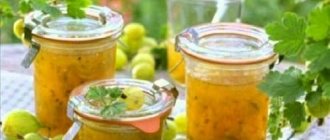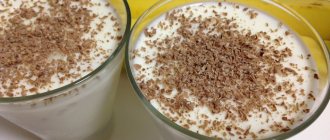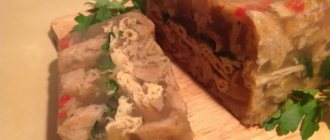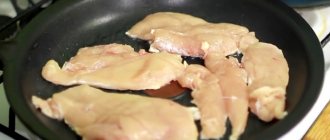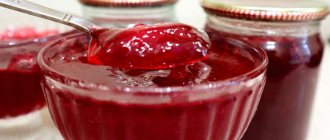Hello, we continue the topic of raspberry canning. And earlier there was a selection of various jams from it. Next up is jelly. It is obtained by boiling the juice and pulp of berries with sugar.
In this case, the gelling ability of the juice is of great importance. The more pectin it contains, the better it gels. Raspberry juice has average capacity, so thickeners in the form of lemon or gelatin are sometimes added to it. Pectin can also be added additionally. We’ll look at how to do this in the recipes themselves.
To preserve the beneficial properties of the jelly as much as possible, it is prepared in a container with a wide bottom to speed up the boiling process. If you have more than 1 kg of berries, then it is advisable to boil them in 1 kg portions. The cooking process should not exceed 30 minutes, otherwise the pectin is destroyed. Therefore, we will not use sterilization in this type of preservation.
Readiness can be checked in three ways: drop the syrup onto a cold dish, if it does not spread and hardens quickly, then it’s ready. A drop of ready-made jelly, dropped into cold water, turns into a ball. The volume of juice at the end of cooking should be no more than 2/3 of the original volume.
Other fruits and berries are rarely added to raspberry preparation, all because it is very aromatic and tasty in itself.
Thick raspberry jelly for the winter without sterilization
First of all, let's look at the classic recipe for making jelly. Since raspberry juice does not contain enough pectin, we will use an assistant. Take 5 g of citric acid per 1 liter of juice with pulp.
Interesting! Lemon stabilizes the gelling, this will prevent the workpiece from becoming sugary and will give the desired thickness. It will also help maintain the jelly’s beautiful rich color.
Let's take:
- 1300 g raspberries,
- 600 g sugar,
- 5 g citric acid.
Step 1. First set the jars and lids to sterilize. We remember that any conservation requires cleanliness.
Separately, rinse the raspberries under water. This must be done, because when boiled, wet berries release juice well and therefore there is no need to add water to the recipe.
Step 2 . Pour the wet berries into a wide-bottomed saucepan. Bring to a boil and cook for 3 minutes. In this case, be sure to stir the fruits with a wooden or silicone spatula.
Step 3. Partially transfer the aromatic mass into a sieve and grind. There is no need to throw away the learned cake; it is better to cook compote on it.
Next, the resulting seedless puree needs to be weighed. For example, we got 900 g.
Step 4. Boil this homogeneous mass over medium heat for about 20 minutes. It will boil down by almost 40%. We weigh it, it turns out to be 600 g of mass. Add sugar to it 1 to 1. For 600 g of mass there are 600 g of sugar.
Immediately add citric acid here and mix the puree, trying to dissolve all the sugar.
Step 5. Do extreme cooking. On medium heat on the stove, bring the raspberries to a boil and skim off any foam that appears. And boil the mass for another 7-10 minutes.
Pour the liquid puree into sterile jars, screw on the lids and turn the preparations upside down.
Be sure to wrap them in a blanket or blanket and leave them alone for a day. During this time, peptide bonds will be actively formed.
After cooling, the jelly will be thick, bright and very tasty. It holds its shape well, is not at all hard and spreads easily on toast.
Bon appetit.
Raw cranberry jelly
You will need:
- Cranberries - 1 kg.
- Granulated sugar - 800 gr.
Recipe:
- Carefully sort the cranberries, wash them and pour boiling water over them for 10 minutes.
- Pass the blanched berries through a meat grinder.
- To obtain juice, filter cranberry puree through cheesecloth folded in 3-4 layers.
- Mix cranberry juice with granulated sugar and stir well until the sugar is completely dissolved.
- After the sugar has dissolved, the jelly must be packaged in jars and refrigerated.
Important: The jelly prepared according to this recipe, that is, without heat treatment, retains a maximum of vitamins and nutrients. In addition, it has a delicious, incomparable taste and aroma.
A simple recipe for raspberry jelly “Five Minutes”
Many housewives have been adhering to a single recipe for making absolutely any preserves and jams for years. It's called "Five Minute". Surprisingly, it is so versatile that it is also suitable for making jelly.
Its meaning consists of several five-minute cooking with alternating cooling of the berries. The density of the workpiece depends on the number of cooking sessions. For raspberry jelly, it is enough to make 3. If you want a more liquid consistency, then do one or two cookings.
On a note! If you do more than 1 brew, then the whole process will require a sufficient amount of time. Sometimes it can take almost two days.
Let's take:
- 1 kg raspberries,
- 1 kg sugar.
Step 1. Immediately cover the berries with sugar. Stir and leave for 3-4 hours to release the juice.
Step 2. Place the pan or bowl with the berry mixture on the stove and turn on the heat to maximum. Bring to a boil. Then reduce the heat to medium and cook the jam for five minutes.
Then remove from heat and let cool for 5-6 hours. During this time, the mass will be well saturated with sugar. Next, grind the mass through a sieve, separating the cake from the pulp and juice.
Step 3. Do a second five-minute cooking. We also record the time after the syrup actively boils. Remove any foam that appears. Then turn off the heat again and leave the puree to cool completely.
Step 4. Before the third final cooking, you need to sterilize the jars and lids.
For the third time, boil the puree from the moment of boiling for five minutes. Look how much it has boiled down. We roll the future jelly into jars and seal them with lids.
Be sure to turn it over and put it on the lids, wrap it in a blanket or rug. The workpieces need to be put away for storage only after 24 hours.
When hot, the jelly will always be liquid; it will show its consistency only after it has completely cooled.
How to prepare jelly
Regardless of what will become the basis of your jelly - berries, fruits or vegetables, you need to wash them thoroughly and squeeze the juice out of them.
Then, in accordance with most recipes (but not necessarily), the juice is filtered using gauze folded in several layers or a flannel bag. Add sugar, gelling agents (if necessary), a little water to the strained juice and cook over low, sometimes medium, sometimes high heat until tender, stirring thoroughly and skimming off the foam.
How to tell when the jelly is ready
The readiness of jelly can be determined in several ways. So, it’s time to put it in jars if:
- it decreased in volume by about 2-2.5 times;
- on its surface no longer small bubbles form, as at the beginning of boiling, but large bubbles;
- the foam does not form as actively as at the beginning of cooking and does not spread over the entire surface of the jelly, but collects in the center;
- a spoon lowered into it is covered with an even layer of jelly, which very slowly flows down it;
- a drop of jelly solidifies on a cold saucer rather than spreading over its surface.
It is even easier to understand how successful your jelly is - it is considered high quality if it has a glassy sheen and the same color as the fruits from which it is made. The finished jelly (without removing the container in which it is cooked from the heat) is quickly distributed into sterilized jars, rolled up with lids, allowed to cool and stored in the same way as any jam. Important: it is better to cook jelly in a wide bowl (thanks to the large bottom and low sides, it boils faster) rather than in a saucepan. If you don't have such a bowl, you can use a short and wide saucepan with a thick bottom. The main thing is not to use enamel dishes with a thin bottom for cooking jam and jelly; in such a container it can burn.
“Live” raspberry jelly for the winter without cooking
Any heat treatment involves the loss of vitamins from any berries and fruits. Unfortunately, this process always happens. Therefore, if you want to preserve absolutely all the vitamins and microelements of raspberries, then you need to put them away for the winter without cooking them.
And there are two options. The first involves double the amount of sugar. Of course, the result is a strong concentrate, but such a preparation can be stored even at room temperature. In the second option, you can, on the contrary, reduce the amount of sugar to 500 g per 1 kg of berries, but then you need to store the workpiece in the freezer. Choose any option. Below I will describe the procedure for preparing “live” jelly.
Let's take:
- 1 kg raspberries,
- 2 kg of sugar (or for storing in the freezer 500-600 g of sugar).
Step 1. To squeeze juice from raspberries, use a screw juicer. She very carefully sorts the pulp with the juice from the seeds.
The cake turns out almost dry. Of course, you can grind the berries through a sieve or squeeze them through cheesecloth, but a juicer will significantly save time on this.
Step 2. Add sugar to the resulting puree, mix thoroughly, trying to completely dissolve the crystals.
Step 3. And pour the mass into containers. We put it away for storage.
If you decide to store the jelly at room temperature and choose the option with double the sugar content, then you need to pour the puree into sterile dry jars. They also need to be sealed with dry and sterile lids.
If you prefer to freeze, then you can pour it into any plastic containers with a lid.
How to prepare “live” jelly
You can make jelly without boiling - using the cold method. Manufacturing by this method will preserve all the vitamins and nutrients, the product will be much healthier than boiled one, which is why jelly prepared in this way is called “live.”
In order to prepare jelly in a cold way, add sugar to the already squeezed and filtered juice, spices or essence if desired, and stir well. After the sugar has completely dissolved, leave the jelly for a while. Then the resulting foam is removed and poured into jars. Store in the refrigerator.
How to make seedless raspberry jelly with gelatin
Now there will be a selection of recipes for making jelly with the addition of thickeners. Let's start with gelatin. It is almost always present in housewives' bins, so making preserves with it will not be difficult.
The consistency of the finished product will be dense and elastic.
Paying attention! Gelatin is produced by denaturation of collagen contained in the bones, cartilage, skin, and veins of animals. Therefore, vegetarians and people of certain nationalities may not eat it.
Let's take:
- 1 kg raspberries,
- 1 kg sugar,
- 2.5 liters of water,
- 50 g gelatin per 1 kg of jelly.
Step 1. Pour water over ripe raspberries and boil for 15 minutes. Pour water to thin the mass, then the pulp will be easier to separate from the seeds.
Grind the hot mass through a sieve, separating the berry puree from the cake.
Step 2. Weigh the resulting homogeneous mass and mix with the same amount of sugar. In this recipe we stick to a 1:1 ratio.
Step 3. We dilute gelatin with water, as described in the instructions. When it swells, melt it in a water bath without bringing it to a boil. When boiling, it loses its gelling properties.
Step 4. Mix the berry mass and boil it on medium heat for 25-30 minutes. Don’t forget to stir it constantly, it will thicken a lot and may burn a little on the bottom.
Check the readiness of the syrup. A drop poured onto a cold plate should freeze. The result is a good dense consistency, which will thicken greatly after cooling.
Step 5. Turn off the heat and let the raspberries cool a little, literally 5-7 minutes. Then pour the melted gelatin into the puree in a stream and mix vigorously.
Pour the jelly into sterile jars.
Roll up with clean lids. And turn the workpieces upside down. We check the tightness of the seaming and cover them with a blanket or towel.
Leave it in this state for a day. And only after that we put the preservation away for storage.
Can be stored anywhere, also at room temperature. But not near heat sources.
Apricot jelly - fragrant
You will need:
- Apricots - 1 kg.
- Sugar - 1 kg.
- Vanillin - a pinch.
- Water - 300 ml.
Recipe:
- Wash the apricots thoroughly, divide them into 2 parts and remove the pits.
- Place the apricot halves in a saucepan with water and boil for 15 minutes (from the moment of boiling).
- Rub the hot apricots through a sieve.
- Add sugar and vanillin to the resulting puree and return to the heat. Boil, skimming off the foam, for about 25 minutes.
- Pour the finished jelly hot into prepared sterilized jars and roll up. Store as usual jam.
Homemade raspberry jelly with agar-agar
The next thickener option is agar-agar. It is also easily introduced into the workpiece and shows amazing results. The jelly turns out homogeneous and elastic. This recipe is quick to prepare. After all, raspberry juice is cooked here for only three minutes.
Agar-agar is a natural ingredient created from seaweed. Most often it is used as a jelly-forming component and thickener in the preparation of confectionery and desserts. Its gelling ability is much better than that of gelatin, so during the cooking process it is required about 3 times less.
Let's take:
- 600 g raspberries,
- 300 g sugar,
- 100 ml water,
- 7 g agar-agar.
Step 1. Pour the berries into the pan. We beat them with a blender.
Pour water into the resulting mass so that the consistency becomes more liquid and passes through the sieve easier.
If the mass still remains thick and does not flow well, then you can add water during the process.
We get beautiful and aromatic berry puree and cake.
Step 2. Mix the puree with sugar and put the mixture on low heat on the stove. You want the sugar to gradually dissolve.
Step 3. Dilute agar-agar with water as described in the instructions. After all, the powder differs from different companies, so there is no uniform instruction.
Pour the resulting mixture into the boiling jelly.
Stir and cook from the moment of boiling for 3 minutes. If foam appears, remove it.
Step 4. Since the jam begins to thicken before our eyes, immediately pour the mixture into prepared sterile containers.
We seal them with sterile lids, turn them over and place them on the lid. Let's put it under the fur coat for gradual cooling.
It must be stored underground after at least 12 hours.
Blackcurrant and citrus jelly
You will need:
- Blackcurrant – 1.5 kg.
- Sugar - 1.2 kg.
- Vanillin - a pinch.
- Lemon - 1 piece (medium size).
- Orange - 1 piece (medium size).
Recipe:
- Wash the currants and use a juicer to squeeze the juice out of the berries.
- Wash the lemon and orange thoroughly, peel and squeeze the juice out of them too.
- Mix blackcurrant, lemon and orange juice.
- Add sugar and vanillin to the juice mixture and simmer for 10 minutes over medium heat, stirring frequently and skimming off any foam that forms. Important : during this time the sugar must dissolve completely.
- Pour the finished jelly hot into pre-sterilized jars and roll up the lids. After cooling, store in a cellar or basement.
Cherry plum jelly
You will need:
- Cherry plum - 1.3 kg.
- Sugar - 1 kg.
- Water - 150 ml.
Recipe:
- Wash slightly unripe cherry plum fruits, remove seeds, and place in a pan with water. Boil until the fruits become soft.
- Drain all the released juice from the pan, and rub the cherry plum itself through a colander, then pass through 2-3 layers of gauze to obtain a fragrant puree.
- Combine the puree with the juice, place over medium heat, and add sugar in several additions. Cook for 25 minutes, stirring occasionally and skimming off foam.
- Pour the finished jelly into sterilized glass jars and seal. You can store the jelly in a cool place.
Mint jelly
You will need:
- Mint leaves - 250 gr.
- Lemon - 2 pcs (medium size).
- Sugar - 1 kg.
- Water - 500 ml.
Recipe:
- Wash the mint leaves, dry a little and chop finely.
- Wash the lemons thoroughly and finely chop them along with the peel.
- Place crushed mint leaves, lemon in a saucepan, add water and, after boiling for 10 minutes, leave for a day.
- After 24 hours, squeeze out the mixture and filter using gauze folded in several layers.
- Add sugar to the resulting mint-lemon infusion and simmer for 30 minutes.
- Pour hot jelly into boiled jars and immediately roll up. Store in a cellar or basement.
Berry jelly recipe. How to make delicious berry jelly at home
Fragrant jelly made from juicy berries is a tasty, light and delicious delicacy, beloved by many adults and children. This dessert can be bought in a store. But it’s much more interesting and healthier to make jelly yourself, delighting your family and friends with an appetizing and healthy treat.
To prepare the dessert, use any berries that are on hand - strawberries, wild strawberries, red and black currants, gooseberries and blackberries, cherries and cherries. Jelly can be prepared for future use and even in cold winter you can treat your household with juicy and aromatic berries, reminiscent of a warm summer.
Content:
Parsley jelly with honey
You will need:
- Parsley (chopped greens) - 10 tablespoons.
- Honey - 500 ml.
- Water - 0.5 l (boiling water).
- Apple vinegar - 100 ml.
- Fruit pectin liquid - 90 ml.
Recipe:
- Wash the parsley well, place in a small saucepan, pour boiling water over it and cover with a lid, leave for 15 minutes.
- After a quarter of an hour, drain all the water - parsley tincture, mix it with honey and bring the mixture to a boil.
- Add vinegar and liquid fruit pectin to the boiled mixture and cook for another 2 minutes.
- Remove the finished jelly from the heat and pour hot into small sterilized jars, roll up. The finished product can be stored in a cool place. Serve with meat, fish and vegetable dishes.
Ingredients
To prepare delicious transparent berry jelly, take the products from the list. Carefully read the packaging of agar-agar, pectin or gelatin - the instructions differ. In my case, instant gelatin is recommended in this ratio - 1 tbsp. l. powder per 400-600 ml of liquid (juice, water, broth, compote, fruit drink, etc.).
I increase the portion of gelatin (instead of one tablespoon, I measure one and a half) to the minimum threshold: 400 ml. The jelly will then turn out stable, dense, and will hold its shape without any problems and “quiver”, as it should be for a dessert.
In the berry mixture, in addition to the main black currant, which gives the main, fresh and sour taste, cherries, cranberries and pieces of apples are added. You have the right to choose raspberries, strawberries, red currants, and other berries. By the way, jams, preserves, and berry syrups are also suitable. Essentially, first we cook a rich compote.
Pour gelatin granules into 2-3 tbsp. l. water (400 ml is possible), leave for 10 minutes (here you should clarify the exact time - read the specific packaging) aside for swelling.
At the same time, boil the remaining water and add the berry mixture (without even defrosting). Immediately add granulated sugar, bring to a boil again and boil for about 10 minutes. Taste, if necessary, increase the amount of sugar. The liquid should be more than moderately sweet.
Strain the compote once or twice, kill all the berries and small cakes. Rinse the container and return the clean compote to it. Add the swollen gelatin and heat again, stirring continuously. We don't boil. Remove from heat as soon as the gelatin has dissolved. Cool to room temperature.
Pour into molds and for complete hardening/setting, place on the refrigerator shelf for an hour and a half. It is advisable to keep it under film to protect it from third-party odors.
Having decorated, for example, with mint branches, we serve the berry jelly to the table.
Apple jelly
You will need:
- Apples - 1.5 kg.
- Sugar - 250 gr.
- Water - 3 glasses.
- Cloves - 1 bud.
- Cinnamon - 1 stick.
Recipe:
- Wash the apples, peel and cut into 4 parts.
- Place the apple slices in a saucepan, add water, cloves, and cinnamon. Cook everything over low heat for half an hour until softened.
- After boiling, drain the resulting juice, remove the cloves and cinnamon from it, and rub the apples themselves through a colander to obtain a puree.
- Mix juice, puree, sugar and simmer for about 30 minutes until thickened, periodically skimming off any foam that forms.
- Pour the finished jelly hot into sterilized jars and roll up. After cooling, store in a cool room.
Jelly can be not only a dessert, but also an excellent addition to meat dishes, the main thing is to prepare it correctly.
Cooking technology
Pour 30 g of gelatin with 3 glasses of cold water. Leave to swell for 20-40 minutes.
Note: If there are other proportions/instructions written on the gelatin packet, be sure to follow them!
We prepare the berry component of the dessert by grinding the berries in a blender (you can use a regular meat grinder).
Pour some of the berries and some sugar into the container.
At minimum speed, grind them into a puree-like mass. Add a little water (if necessary, if the puree is very thick) and beat again.
Pour the resulting puree into a saucepan through a sieve (it can be replaced with several layers of gauze).
During straining, excess cake and seeds are retained.
As a result, the saucepan ends up with clean, fairly liquid berry puree and juice.
We continue preparing the puree until we get the required volume of berry mass (4 cups).
We return to the already swollen gelatin. Place it on low heat and dissolve, stirring constantly. It is strictly forbidden to boil gelatin, therefore, as soon as all the lumps have dissolved, remove it from the heat and pour it into the berry mass.
Note: If the gelatin is not completely dissolved, when pouring it into the berries, use a sieve to avoid lumps in the jelly.
Mix gelatin and berries thoroughly. We spread the mass into any shape.
Note: It doesn’t matter if you pour the jelly into glass or plastic containers - in any case, it will harden.
For beauty and taste, you can add berries or pieces of any fruit to the jelly.
Place the molds in the refrigerator for several hours until completely set. The lower the temperature, the faster the jelly will set.
In the summer heat, jelly must be removed from the refrigerator immediately before use to prevent it from softening.
Step by step cooking method
To prepare this dessert, you must use only fresh red currants. It is separated from the branches and placed in a sieve. After thoroughly washing the berries, they are placed on a towel and dried. After this, the product is placed in a bowl and covered with granulated sugar.
After carefully mixing the currants (so as not to harm the integrity of the fruit), they are left at room temperature for several hours. In the meantime, begin preparing the gelatin.
It is filled with ordinary water at room temperature and heated very slowly over low heat. When the gelling substance has completely melted, remove it from the heat and cool slightly.
After the described steps, the gelatin mixture is poured into the berries and mixed thoroughly. Next, the resulting mass is distributed into bowls and sent to the refrigerator. After 5-7 hours, tasty and healthy red currant jelly is considered completely suitable for consumption. It is served to the table with a dessert spoon, first sprinkled with powdered sugar.
The beauty of homemade jelly is obvious: it can be prepared to your taste, based on the resources available. Absolutely any berries are used, and it doesn’t really matter whether they are fresh or frozen. A homemade product, which is important, allows you to regulate the degree of sweetness, while store-bought jelly desserts are often overly cloying. And this is not to mention the use in mass production of various additives that are of little benefit to health.
In our case, with a minimum set of necessary components and minor labor costs, we get a natural, tasty treat for the whole family - from young to old.

